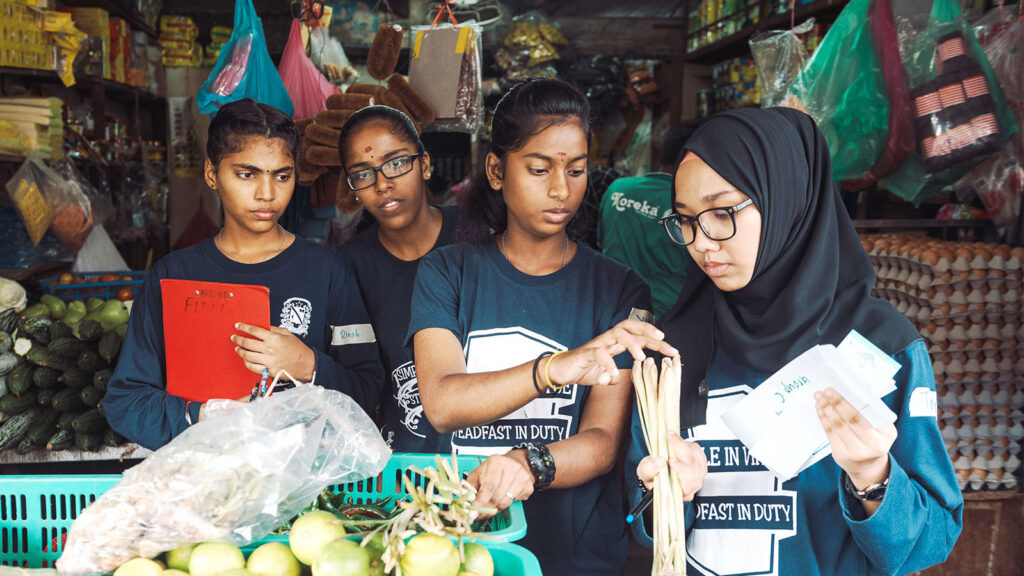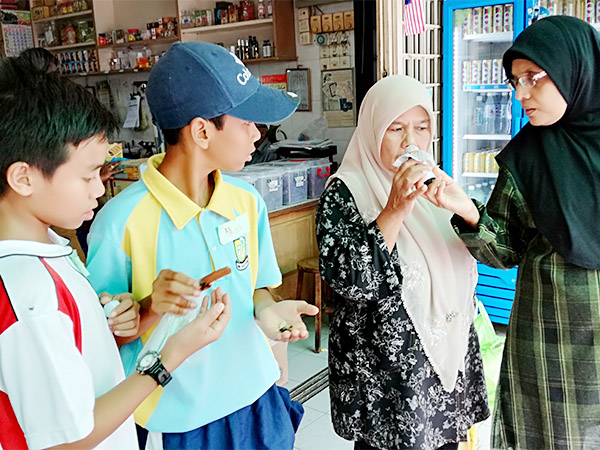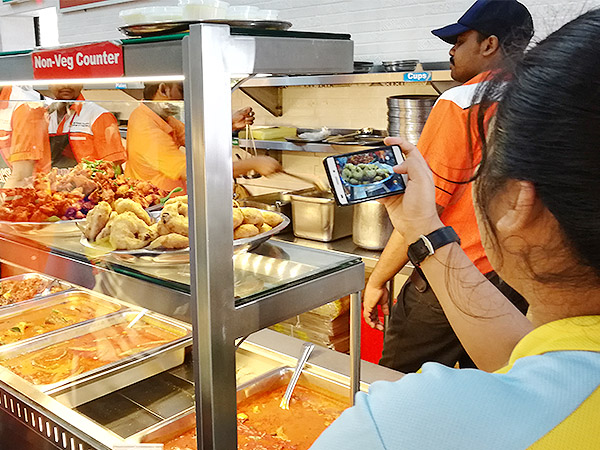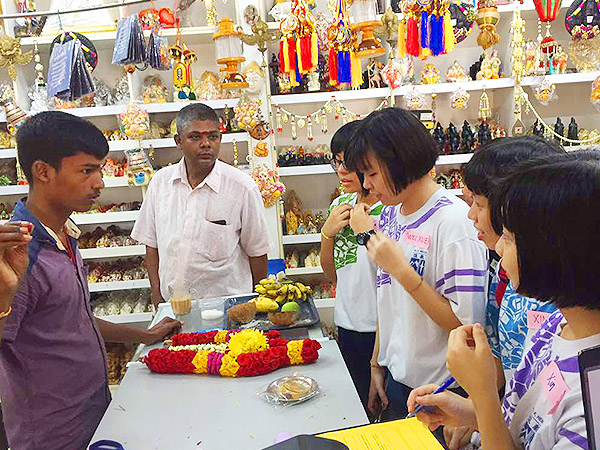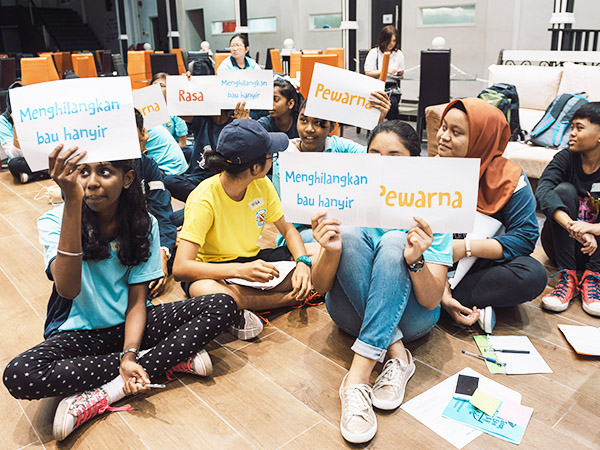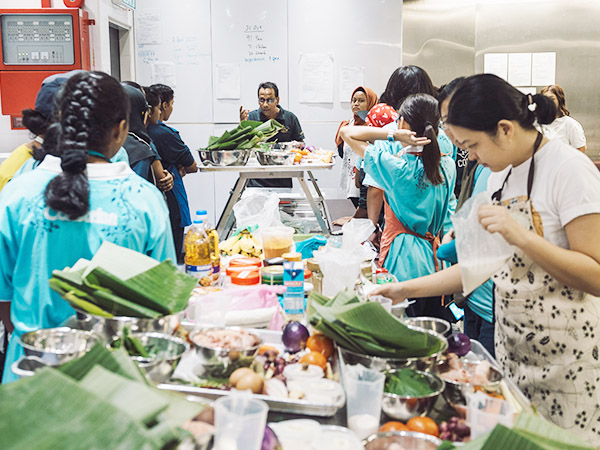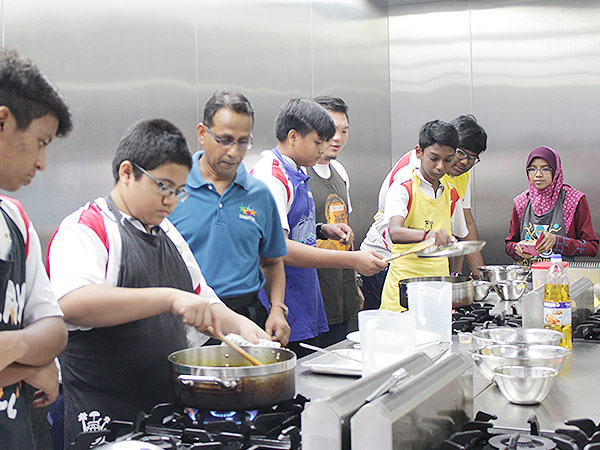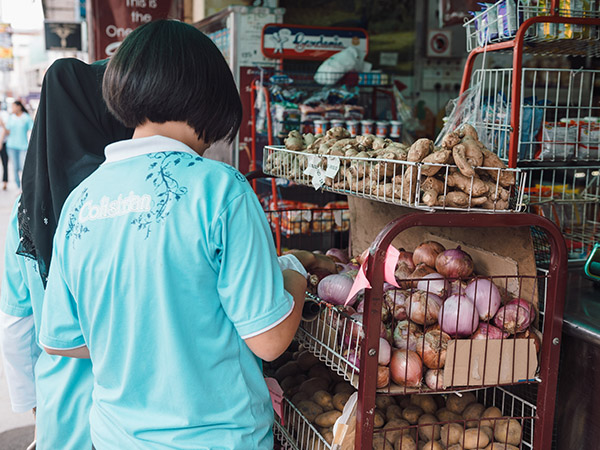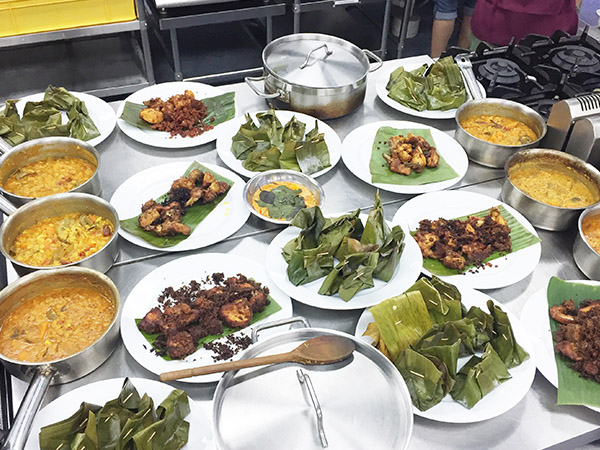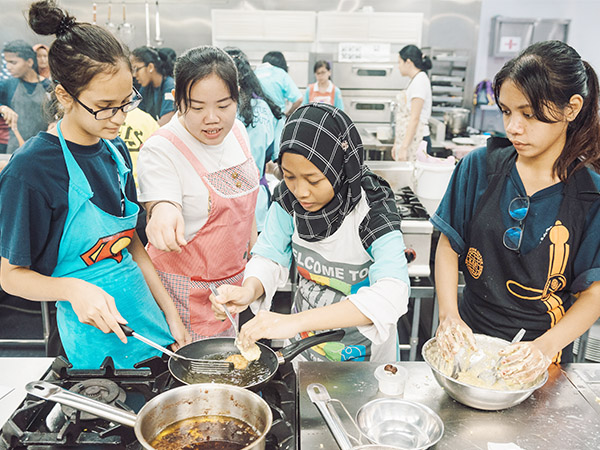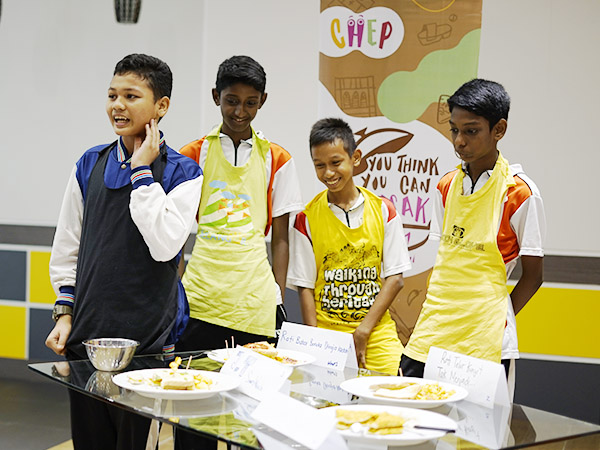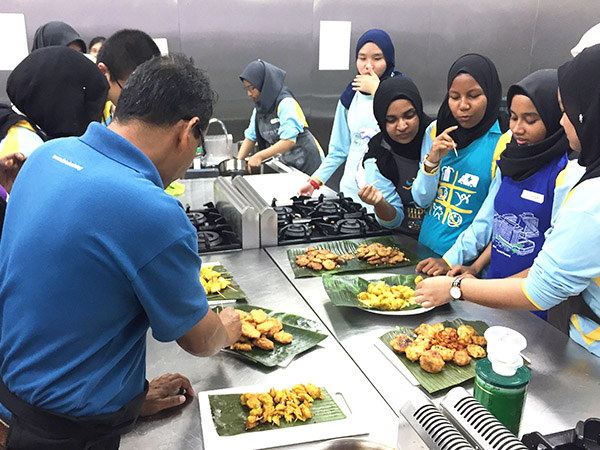Treasures of Turmeric
What are the uses and benefits of spices, specifically turmeric? Participants explore the uses of turmeric by various cultural groups through cooking and experiential activities.
Project at a Glance
Driving Questions
What can turmeric tell us about cultural heritage and diversity?
Creative Medium
Cooking
Community
Local residents of George Town, Penang
Participants
13–16 year olds
Human Resources
Individual with extensive knowledge of local culinary history and hands-on cooking experience; Facilitator with cooking experience
Timeframe
9.5 hours
Relevant Subjects
Home Science, Social Studies

Knowledge
- Understand turmeric’s history, cultural significance, and uses in different cuisines and communities.
- Gain knowledge of turmeric’s various health benefits and its role as a spice in cooking.

Skill
- Develop cooking skills and techniques, including using turmeric in various dishes and creating new culinary creations.
- Improve teamwork, communication, and collaboration skills by working with other participants on cooking tasks and presentations.

Value
- Appreciate cultural diversity and heritage through learning about the use of turmeric in various cuisines and communities.
- Develop a sense of pride in their own cultural heritage and be motivated to preserve their cultural knowledge and practices.
Suggested Activities:
FAMILY AND NEIGHBOURHOOD – Share newly-acquired culinary skills by cooking dishes and new turmeric-based snacks for family members and the community.
SCHOOL – Set up a booth during School Canteen Day cooking dishes that showcase the uses of turmeric in different cultures.
FAMILY, SCHOOL AND BEYOND – Record the cooking process along with explanations of the use of turmeric in the dishes and post the video on social media.
Context and Citizenship
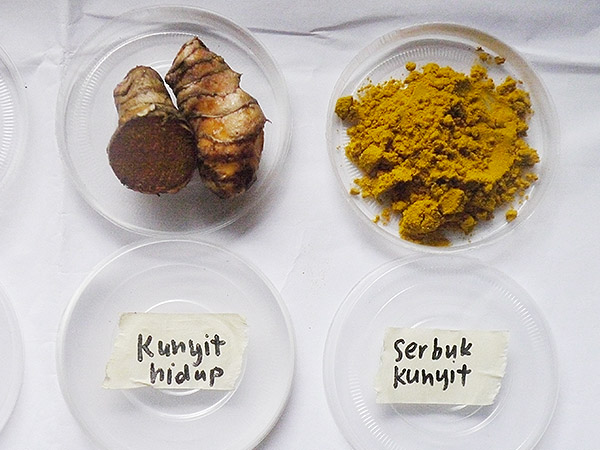
Spices have been a crucial part of human culture and diet for generations, serving as flavouring agents, preservatives, and even medicines. One such spice is turmeric, a member of the ginger family and a bright and versatile ingredient.
Turmeric is used in powder form in traditional Indian medicine to treat conditions such as inflammation, digestive problems, and skin issues. It is also a vital component of the culinary traditions of South and Southeast Asia and the Middle East, with dishes like curries and lentil preparations featuring it prominently. Some cultures also use turmeric as a natural food colouring or preservative. Beyond its culinary uses, turmeric is important in religious and cultural rituals. In Hinduism, it is regarded as a sacred spice and employed in various ceremonies. It can even be used as a clothing dye or a symbol of prosperity in certain South Asian cultures.
Turmeric’s diverse cultural and historical significance makes it a significant ingredient in many global cuisines, representing the connections between different cultures and their food traditions. By exploring the role of turmeric in food and culture, we can better understand the various cultural practices and traditions associated with this spice and gain a deeper appreciation for the rich heritage of the regions where it is used.
Components of Learning
Activity 1 - Hands-on Introduction to Spices
To introduce participants to commonly-used spices, participants touched and smelled spice boxes that contained cinnamon sticks, star aniseed, clove, cumin, fennel, black pepper, cardamom, coriander, dried chilli, ginger, and turmeric.
Focusing on turmeric, the facilitator explained:
- its different forms;
- its name in English, Tamil, and Malay; and
- its various uses in food, prayers, and beauty products.
To generate further curiosity regarding turmeric, the facilitator guided participants to experiment with adding an acidic substance (e.g. lemon juice) and an alkaline substance (e.g. baking soda) separately to turmeric powder and observed how turmeric reacted to the two substances. As turmeric is a natural pH indicator, it remained yellow when in contact with acidic substances and turned red when in contact with alkaline substances. (See Additional Resources at the bottom of the page for more information about the Turmeric pH indicator experiment.)
Activity 2 - Spice Hunt
To familiarise participants with commonly-used spices and where turmeric can be found in everyday foods and cultural practices, participants went on a Spice Hunt in Little India. In small groups, participants completed the following tasks based on a worksheet given:
- Identify spices in four mystery bottles only by smell, and either draw the appropriate spice on their answer sheet or bring back a sample.
- Take a photo of three types of food that use turmeric.
- Take a photo of non-food/drink uses of turmeric.
After verifying the answers and photos for the three tasks at the end of the hunt, participants were given three pre-packaged spice mixes that are usually used in different cultures and were challenged to answer the following:
- Are the four mystery bottle spices present in the three pre-packaged spice mixes?
- Are there any spices that were common across the three pre-packaged spice mixes?
- What are the dishes that use each mix?
This activity allowed participants to understand that there were some similarities in the use of spices in cooking by different groups of people despite cultural differences.
Available download(s) for activity:
Activity 3 - Discovery of Spice Trade History
The facilitator distributed picture cards showing key events in the history of spice trade to each group and asked them to arrange the cards chronologically. During this activity, the facilitator encouraged the participants to discuss the value and usage of spices in different cultures.
The facilitator then connected the history of the spice trade to the local community site. Based on their exploration onsite earlier, participants identified and shared the daily uses of turmeric in the community.
As homework, participants shared a family recipe that uses turmeric on Instagram or Facebook with the hashtag #syiokkunyit.
Available download(s) for activity:
Activity 4 - Turmeric Recipes and Functions
In small groups, participants shared the stories behind turmeric-related recipes from home. Then, in a big group, they compared and contrasted the ingredients in the dishes shared, the cooking methods, cultural background, and occasions during which the dishes are enjoyed.
The facilitator then led a guessing game on the functions of turmeric. Each group was given signs for three functions:
- Colouring
- Flavouring
- Eliminating germs and bad odours
Based on images shown by the facilitator, groups that correctly guessed the function earned a point. This activity helped participants understand the cultural and health benefits of turmeric.
Available download(s) for activity:
Activity 5 - Cooking of Local Dishes
Before discovering the dishes they would make, participants were given a map, shopping list, and cash to buy the necessary ingredients. The facilitator checked their budget and ingredients before they were permitted to enter the kitchen.
Once inside the kitchen, participants received instructions from the chef on kitchen rules, four local dishes to cook (nasi briyani, otak-otak, ayam goreng berempah, and dhal), and the flow of preparing each dish. As they cooked collaboratively, the chef supervised as well as emphasised the functions of turmeric in each dish and the reasoning behind the cooking methods.
Activity 6 - Turmeric Snack Innovation
After preparing and enjoying the four dishes, participants were challenged to create a new turmeric-based snack. The chef reviewed deep frying, sauteing, steaming, and boiling skills. Each group was given a mystery ingredient, a worksheet, and a choice of other ingredients to prepare the snack within 30 minutes. Then, each group presented their snack invention for a taste test by other groups.
Activity 7 - Reflection
After the facilitator shared a recap of the programme, participants reflected on their experience by writing their thoughts on sticky notes based on the following questions:
- What were three new things you learned in this project?
- How did you feel about the project experience?
- Will you try dishes from other cultural groups?
- Beyond cooking, how do you plan to use what you have learned about turmeric?
Activity 8 - Community Sharing
Although this activity was not carried out in the original project, educators are encouraged to do so to reinforce participants’ learning.
Participants can improve their turmeric-based snack innovations and share them in a local community event. In addition to presenting their creations, participants can also share the insights they gained from the programme related to the functions and benefits of turmeric and its uses in different cultures. Community members can also be invited to share their family recipes that use turmeric and related memories.
How to Adapt

Community
What other spices are significant to your community that participants could explore instead of turmeric or that can be compared and contrasted with turmeric? For example, consider peppercorn, clove, and cinnamon sticks.

Creative Medium
What mediums might suit participants to learn about turmeric and share their learnings besides cooking and innovating dishes? You could consider letting participants explore a non-food product that uses turmeric and produce an innovation based on the product.

Topic
What are some ways to deepen the participants’ learning? Consider exploring the supply chain of turmeric (or other spice of focus) and its sustainability. For inspiration, check out the Secrets of Coconut project.
This project was originally conducted in You Think You Can Masak, Cultural Heritage Education Programme (CHEP).
Additional Resources

